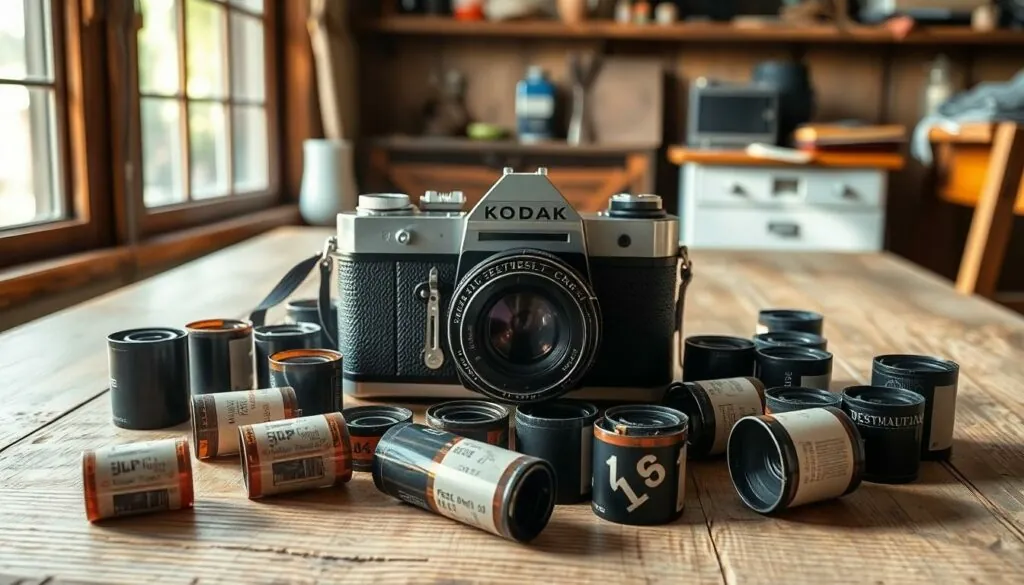Table of Contents
ToggleImagine a world where every photo you took turned out like a potato with a bad filter. Thankfully, that’s not the case, thanks to the brilliant minds behind negative film. This groundbreaking invention transformed photography from a hit-or-miss endeavor into a reliable art form, allowing photographers to capture moments with clarity and depth.
The Invention of Negative Film
Negative film transformed photography by allowing for greater control in image reproduction. This innovation led to a significant shift in how photographers approached their craft.
Early Developments in Photography
Early photography utilized processes like daguerreotypes and calotypes, which provided limited flexibility. Daguerreotypes, developed by Louis Daguerre in 1839, produced a single positive image on a polished metal plate. In contrast, calotypes, invented by William Henry Fox Talbot, used paper negatives to create multiple positive prints. These methods laid the foundation for future advancements. By the late 19th century, the demand for more user-friendly options prompted further innovation in photographic techniques.
Key Contributors to Negative Film
George Eastman played a significant role in popularizing negative film. In 1888, he introduced the Kodak camera, which utilized a flexible roll of negative film, simplifying the photography process. The introduction of gelatin silver process in the 1880s also marked a key development. This process allowed for greater sensitivity and better quality images. Other contributors like Joseph Niépce and Talbot laid essential groundwork, influencing photographic processes that led to the evolution of flexible negative film. Their collective efforts shaped the course of photography, making it accessible to the masses.
Understanding Negative Film
Negative film plays a crucial role in photography, enabling precision in image capture. Photographers rely on this medium for its unique ability to produce clear images with depth.
The Chemistry Behind Negative Film
Negative film comprises multiple layers, each designed for a specific purpose. Light-sensitive silver halides reside within the emulsion layer, reacting when exposed to light. This reaction creates a latent image that later becomes visible during development. During the development process, these exposed silver halides convert into metallic silver, forming the dark areas of the image. An essential step involves using a fixative, which halts the development process and preserves the image. Understanding this chemical process helps photographers appreciate the science behind their craft.
Types of Negative Film Used
Different types of negative film cater to various photography needs. Color negative film remains popular for its vibrant reproductions and excellent exposure latitude. Black and white negative film, on the other hand, offers a classic aesthetic that highlights contrast and texture. Specialty films, such as infrared and slide films, provide unique artistic effects. Additionally, the ISO rating varies among these films, affecting their sensitivity to light. Photographers select the type of film based on the desired outcome and shooting conditions.
The Role of Negative Film in Photography
Negative film plays a crucial role in photography, enabling photographers to achieve precision and artistic expression through image capture and development.
How Negative Film Captures Images
Light-sensitive silver halides in the film’s emulsion layer react when exposed to light, forming a latent image. The exposure creates varying densities on the film, translating highlights and shadows. Negative film captures scenes with remarkable detail, allowing for various scenes to be reproduced accurately. Color negative film, for instance, records colors in a way that enhances natural hues in the final print. Black and white negative film emphasizes contrasts, making it ideal for artistic expression. Photographers select their film based on desired effects, ISO sensitivity, and the characteristics of the scene.
Developing Negative Film
Developing negative film involves a series of chemical processes that reveal the captured image. Exposed silver halides convert into metallic silver during development, creating a visible image on the film. The first step in the process includes the developer, which initiates the transformation of the latent image. Following this, a stop bath halts the development to maintain image integrity. Fixative then removes any unexposed silver halides, preserving the developed photo. Once complete, the negative can be printed using an enlarger or scanned for digital use, allowing photographers to share their work in various formats. Different developing techniques can tailor the image to suit distinct artistic goals.
Advantages and Disadvantages of Negative Film
Negative film offers several advantages that appeal to photographers. Its wide dynamic range allows for capturing images with significant detail in both shadows and highlights. Photographers appreciate the versatility of color negative film, as it accurately represents a vast array of hues and tones. Black and white negative film, on the other hand, provides high contrast and artistic opportunities that some photographers seek.
Another benefit lies in the ability to produce prints from negatives. High-quality enlargements can be made, providing detailed images that maintain richness in texture and depth. Additionally, negative film possesses a forgiving nature; overexposure or underexposure often leads to usable images rather than complete failures.
Despite these advantages, negative film has drawbacks that can influence choices. The development process requires specific chemicals and equipment, which can create challenges for some photographers. Time invested in developing and printing might deter others who prefer instant digital results.
Another significant disadvantage is the limited ISO flexibility. While negative film has inherent light sensitivity, adjusting this sensitivity isn’t as straightforward as changing settings on a digital camera. Photographers need to carefully plan for lighting conditions to achieve the desired results.
Costs also present a factor. Purchasing and developing film incurs expenses that can accumulate quickly, particularly for those who shoot frequently. In comparison, digital photography offers cost-efficiency with immediate results and easier editing.
Negative film excels in unique characteristics and aesthetic charm. At the same time, it introduces complexities that require careful consideration for effective use in photography. Each photographer must weigh these aspects when deciding between negative film and alternative formats.
Conclusion
Negative film has undeniably shaped the landscape of photography. Its invention marked a pivotal moment that allowed photographers to express their creativity with precision and control. The ability to capture images with depth and clarity transformed not only the technical aspects of photography but also its artistic potential.
As photographers continue to explore both traditional and digital methods, negative film remains a cherished medium. Its unique characteristics and aesthetic appeal offer a distinct experience that many still value. Understanding the intricacies of negative film enhances appreciation for this art form and its ongoing influence in the world of photography.







